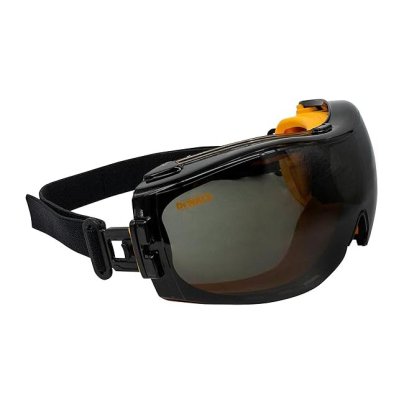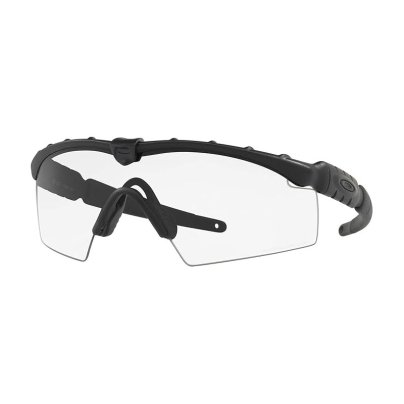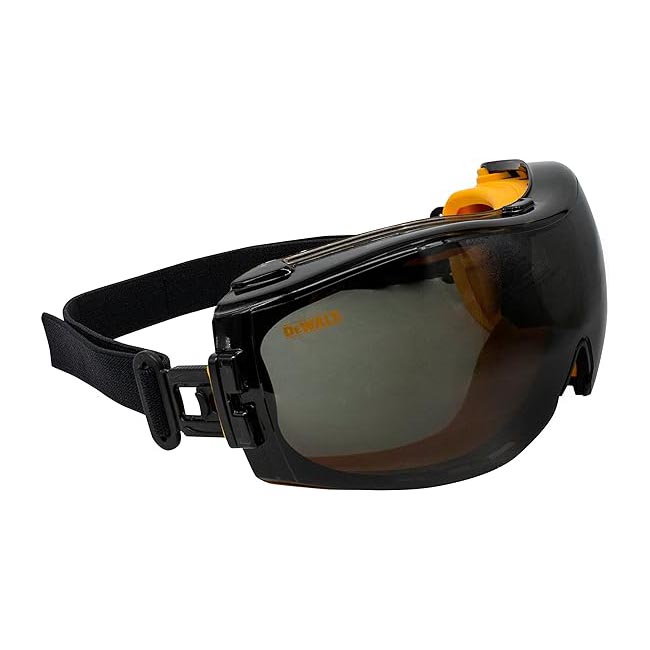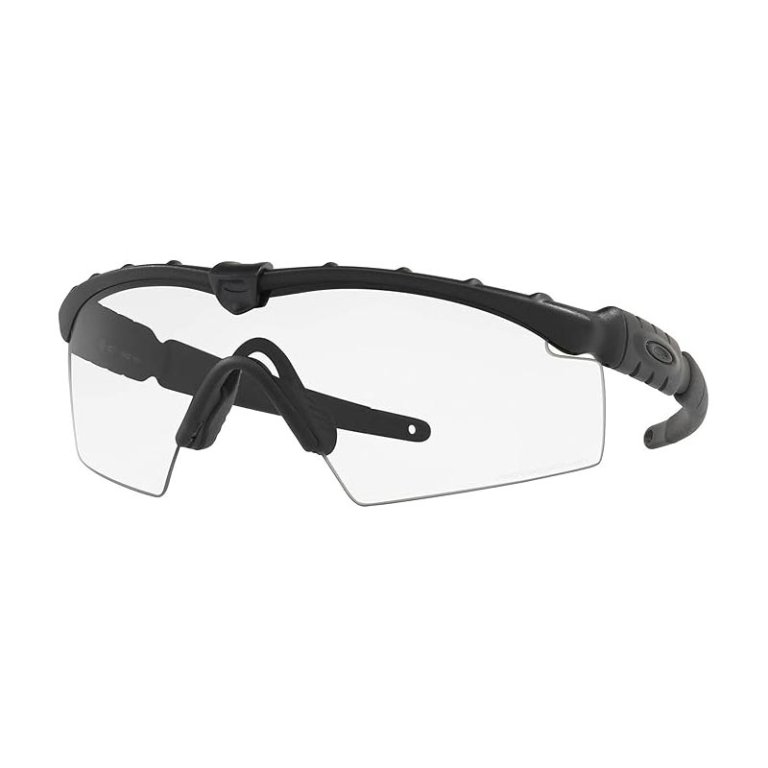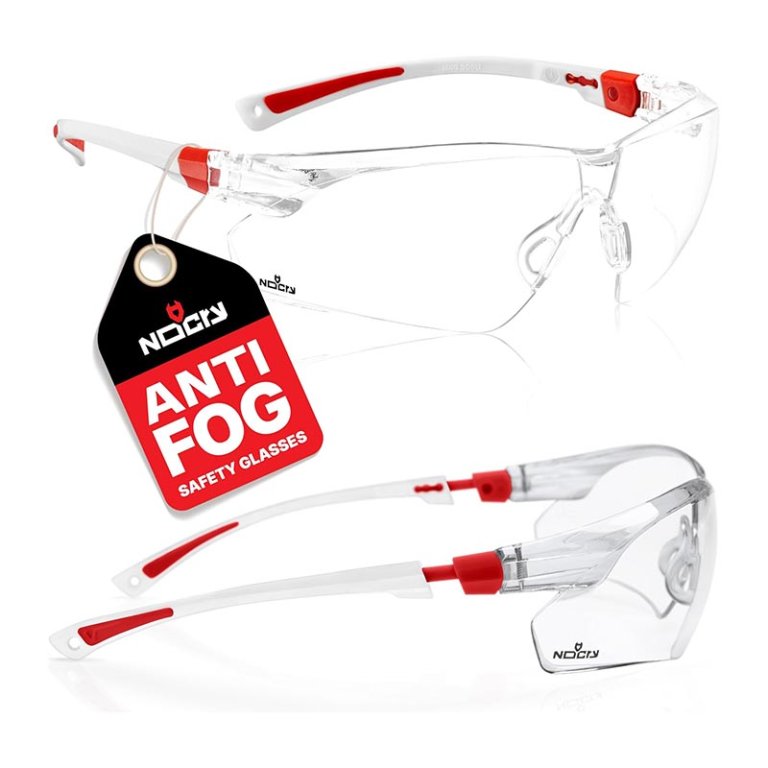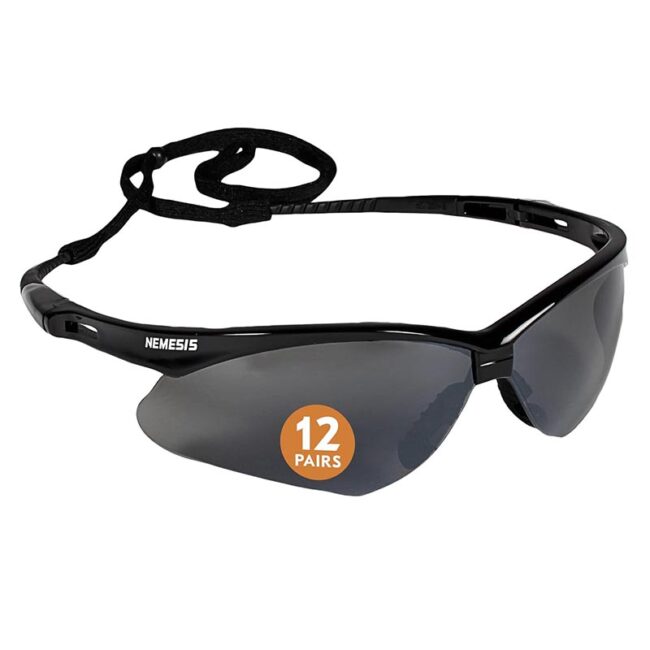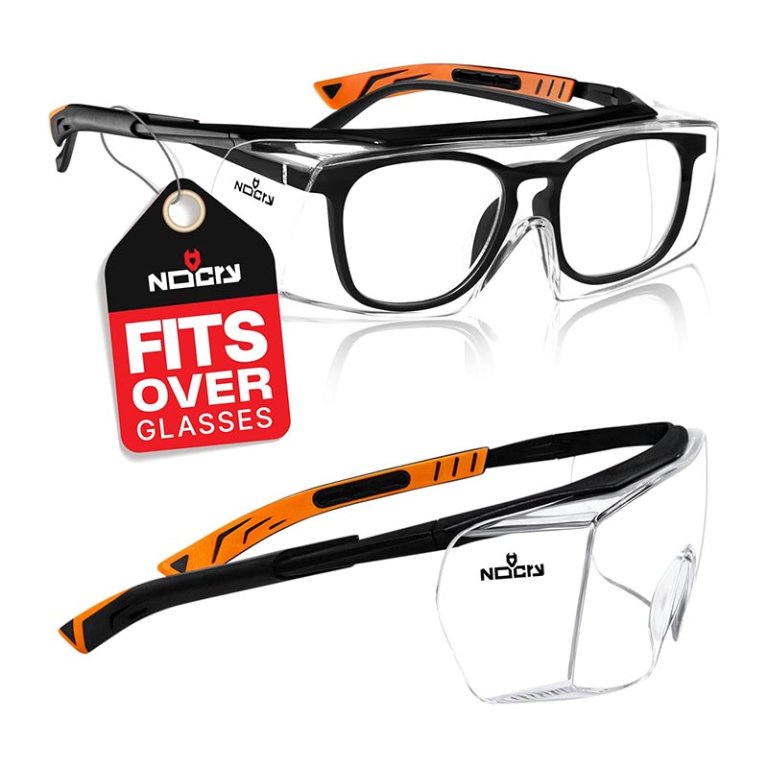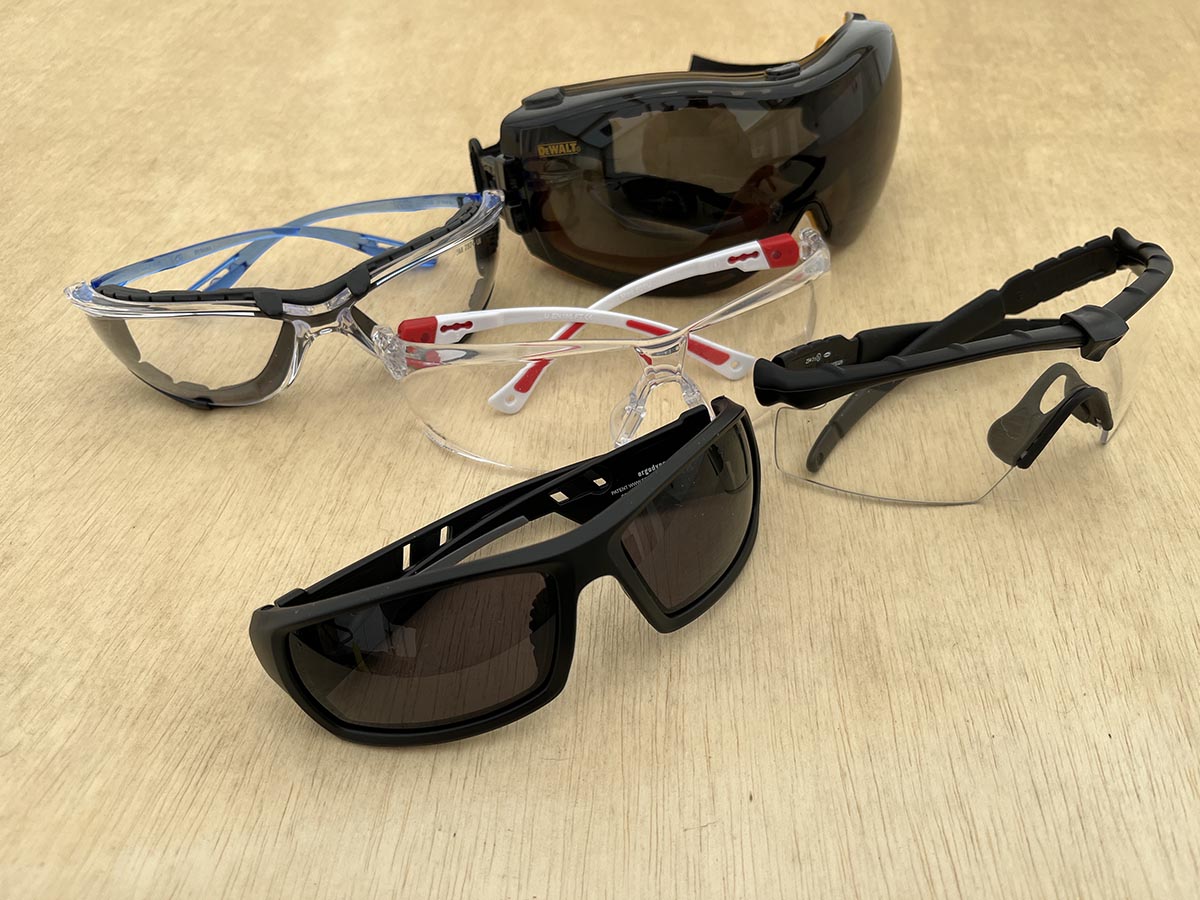
We may earn revenue from the products available on this page and participate in affiliate programs. Learn More ›
Most home improvement projects call for some form of protective gear, like high-quality safety glasses, to prevent injuries. Whether trimming the lawn, lying in the close quarters of a crawl space fixing a broken pipe, or sawing a few 2x4s in the garage, protective eyewear helps to preserve vision. There are plenty of functional and stylish options to pick from. After testing five pairs of really good safety glasses for this guide, we chose 3M Virtua Protective Eyewear as Best Overall due to their excellent visibility and high degree of impact protection for common indoor and outdoor tasks. They were also affordable and comfortable.
Some projects may call for more advanced or more rugged safety glasses than our top pick offers. In those cases, or as a matter of individual fit or style, one of the other safety glasses in this guide might be a better choice. Read on to learn more about what to look for when shopping for eye protection and check out all the options that we rated as the best safety glasses in their class.
- BEST OVERALL: 3M Virtua CCS Protective Eyewear With Foam Gasket
↓ Jump to Review - BEST BANG FOR THE BUCK: DeWalt DPG82 Concealer Safety Goggle
↓ Jump to Review - UPGRADE PICK: Oakley Oo9213 M Frame 2.0 Industrial Safety Glasses
↓ Jump to Review - BEST ANTI-FOG: NoCry Clear Anti-Fog Safety Glasses
↓ Jump to Review - PERFORMANCE PICK: Ergodyne Skullerz Odin Safety Glasses
↓ Jump to Review - BEST POLARIZED: KleenGuard V30 Nemesis Safety Glasses
↓ Jump to Review - BEST OVER GLASSES: NoCry OverSpecs+ Over Glasses Safety Glasses
↓ Jump to Review

| Lens | Seal | Frame | Style | |
| 3M Virtua CCS Protective Eyewear | Anti-fog, UV protection | Removable foam gasket | Semi-rimless | Traditional |
| DeWalt Concealer Safety Goggle | Tinted, anti-fog, scratch-resistant, UV protection | Dual injection molded rubber gasket | Full-rim goggle | Wraparound |
| Oakley Oo9213 M Frame 2.0 Safety Glasses | Anti-fog, UV protection | None | Semi-rimless | Wraparound |
| NoCry Safety Glasses | Anti-fog, scratch-resistant, UV protection | None | Semi-rimless | Wraparound |
| Ergodyne Skullerz Odin Safety Glasses | Tinted, UV protection | Optional gasket | Full-frame | Traditional |
| KleenGuard V30 Nemesis Safety Glasses | Tinted, UV protection | None | Full-frame | Wraparound |
| NoCry Overspecs+ Safety Glasses | Scratch-resistant, UV protection | None | Semi-rimless | Traditional |
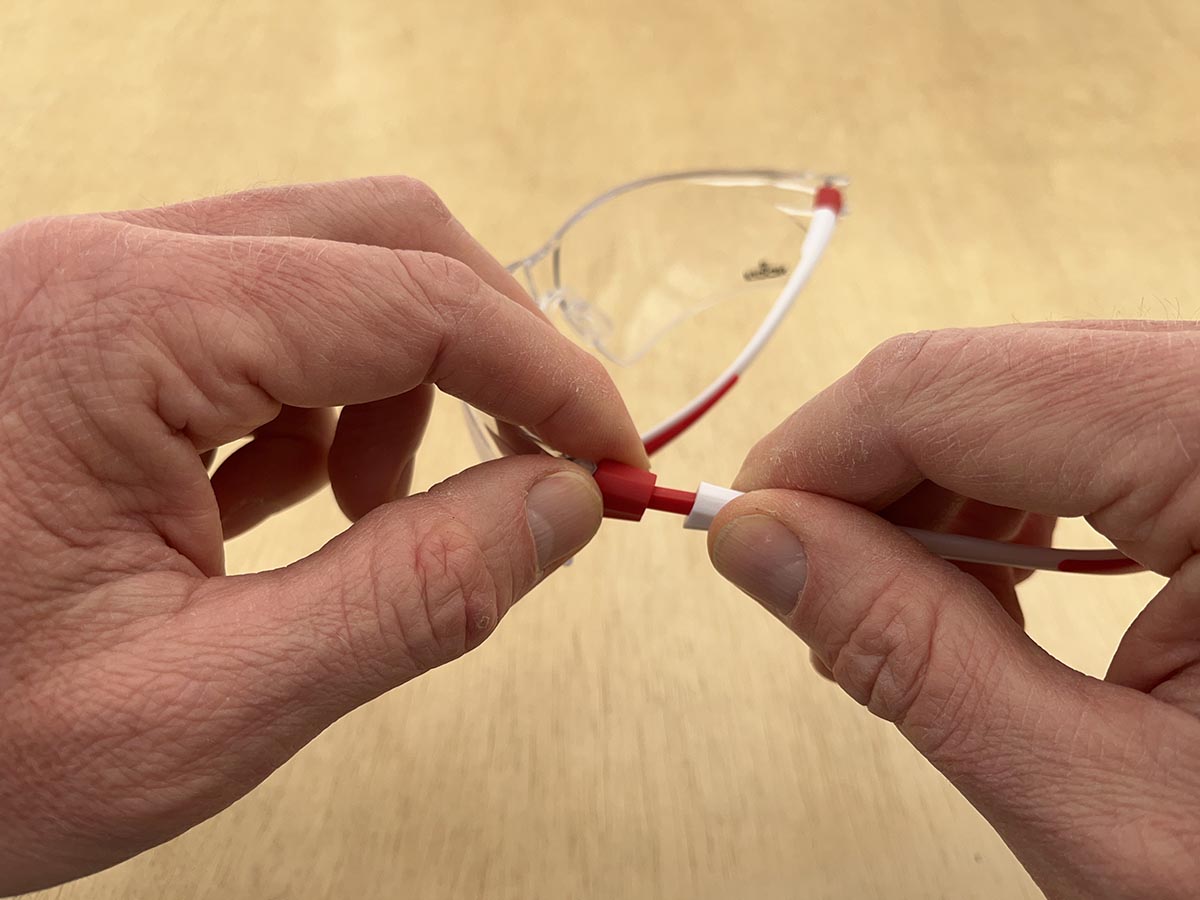
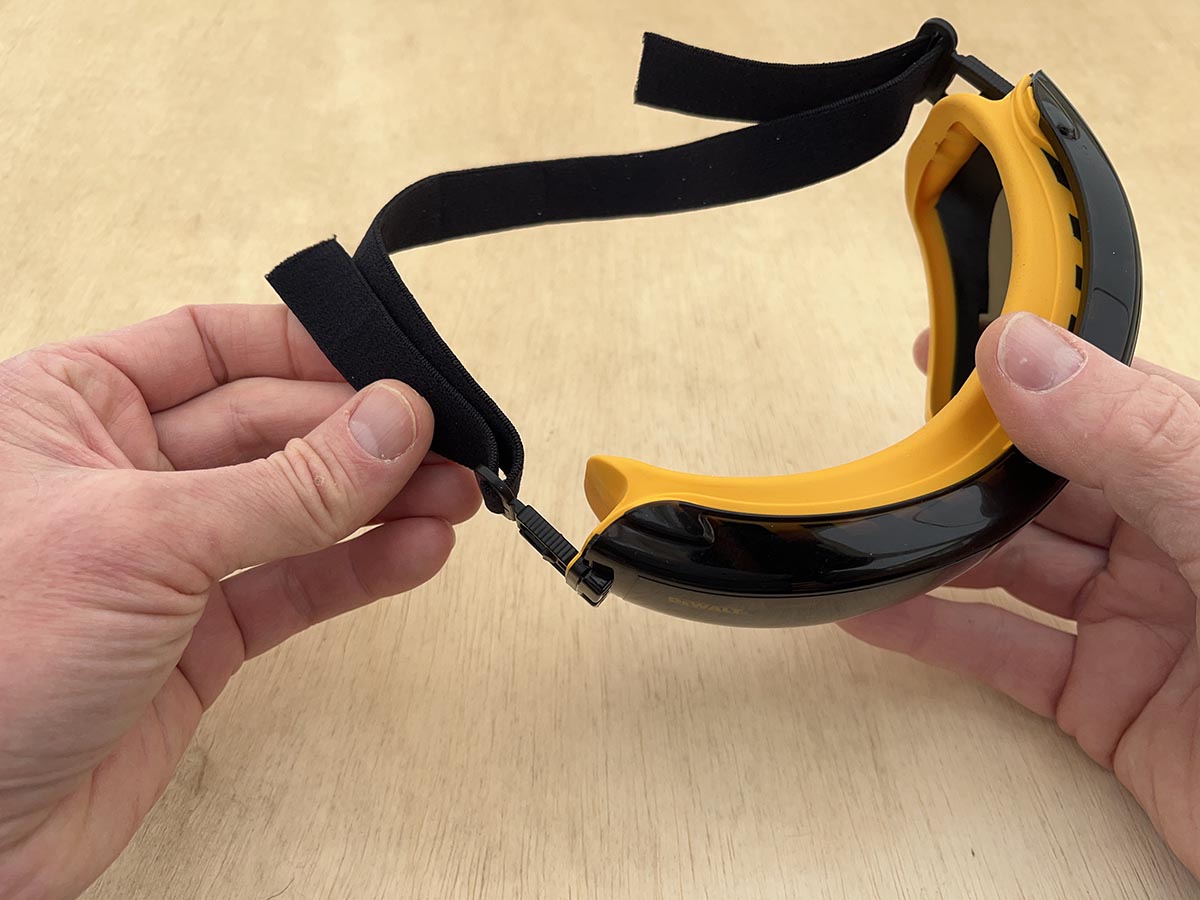
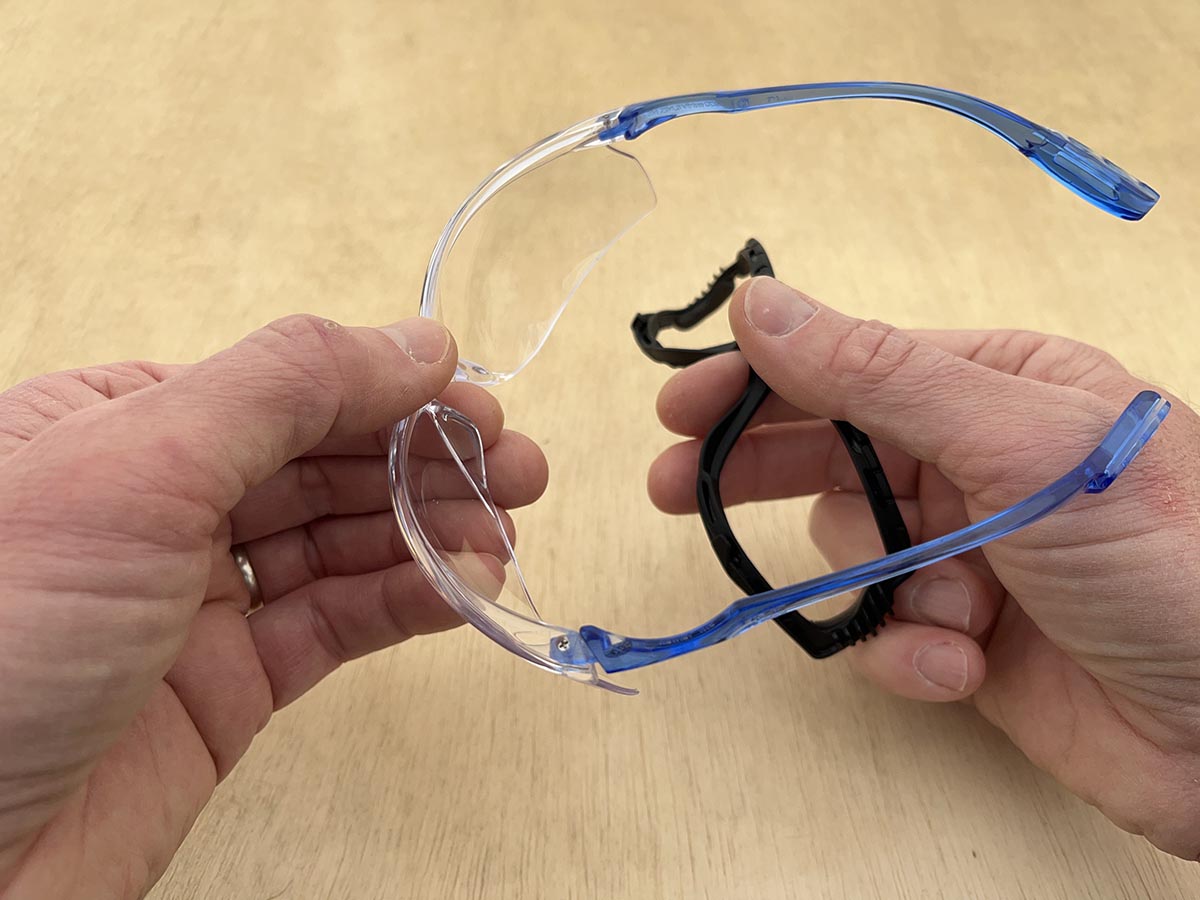
Our Top Picks
These safety glasses rate as best based on design, cost, and overall satisfaction of users in both residential and professional settings. We tested each pair, taking into account important product features and with special attention to durability, peripheral coverage, and scratch resistance, to find the best safety glasses to wear during home improvement projects.
Best Overall
3M Virtua CCS Protective Eyewear With Foam Gasket
What We Like
- Close fit to block out fine particles
- Removable gasket
- Lightweight, very comfortable for extended wear
- Good peripheral protection
What We Don’t Like
- Clear, non-polarized lenses are less helpful for outdoor work
Specs
- Impact ratings: ANSI Z87.1, CSA Z94.3
- Lens material: Clear polycarbonate
- Lens resistance: Fog, UV
Our Ratings: Comfort 5/5; Functionality 4.5/5; Protection 5/5; Durability 5/5; Value 5/5
3M’s Virtua CCS clear safety glasses are lightweight, comfortable, and offer good protection for projects around the house or working in the yard. As with all of the other work glasses in this guide, they carry an ANSI Z87.1 impact rating–a key OSHA safety standard for eye protection. They also feature a wraparound design for added peripheral protection, anti-fog lenses with UVA and UVB protection, and a removable foam gasket that clips on the frame to help seal out dust and debris.
We tested 3M’s Virtua CCS safety glasses on a multitude of projects, including drilling, cutting with a circular saw, driving nails, and mowing grass. They were still comfortable after two hours of wear, and visibility was never compromised. The foam gasket did not seal as well as the goggles, so we don’t recommend them as chemical safety goggles, but they noticeably reduced dust intrusion while working with a circular saw. Also, when working outside on sunny days, non-tinted and non-polarized safety glasses may not be the best option; the UVA and UVB protection offers sun protection but won’t improve vision in bright sunlight.
What our tester says: “The 3M Virtua glasses were very lightweight and comfortable, but the big revelation was the removable gasket. Without it, I was still getting sawdust in my eyes. But with it in place, no debris got through between the lens and my cheek.” —Mark Wolfe, Product Reviews tester and writer
Get the 3M Virtua CCS safety glasses at Amazon, Walmart, Magid, or Safety Glasses USA.
Best Bang for the Buck
DeWalt DPG82 Concealer Safety Goggles
What We Like
- Close fit to block out fine dust and mist
- Wraparound design maintains high visibility
- Available with tinted or clear lens
- Anti-fog coating worked perfectly
What We Don’t Like
- Uncomfortable in hot weather
- Strap angle is not adjustable
Specs
- Impact ratings: ANSI Z87.1
- Lens material: Tinted polycarbonate
- Lens resistance: Fog, scratch, UV
Our Ratings: Comfort 4/5; Functionality 4/5; Protection 5/5; Durability 5/5; Value 5/5
When working with dangerous power tools, eye protection is obviously necessary—but there are plenty of other occasions when it’s important. When working with potentially harmful liquids or when fine dust particles are an issue, DeWalt Concealer Safety Goggles are a perfect fit. They have a dual injection-molded seal that comfortably conforms to the face and a ventilated anti-fog lens that provides outstanding visibility. An adjustable cloth elastic strap secures them in place.
DeWalt Concealers are available with tinted or clear lenses, both of which offer UV protection. Even though these goggles have a snug fit on all sides, the large lens makes it easy to see the work at hand. In every one of our tests, visibility was more than adequate. The gasket sealed out mist and dust perfectly. But the angle of the elastic strap did not feel quite right. Although the strap length was adjustable, the attachment angle could not be adjusted. The goggles became uncomfortably warm while working in 80-degree temperatures. For those who need the added protection of safety goggles, DeWalt Concealer glasses offer excellent impact protection and a really good seal. But if comfort is the top priority, we would suggest trying one of the other work glasses first.
What our tester says: “Not every job requires the added protection of goggles, but the DeWalt Concealers did a fantastic job deflecting fast-moving debris and keeping sawdust and other fine particles from getting behind the lens. The molded gasket sealed perfectly around my eyes without the need for excessive pressure.” —Mark Wolfe, Product Reviews tester and writer
Get the DeWalt safety glasses at Amazon, The Home Depot, or Walmart.
Upgrade Pick
Oakley Oo9213 M Frame 2.0 Industrial Safety Glasses
What We Like
- Very lightweight and close-fitting
- Crystal clear lenses
- Highest impact resistance among the test group
- Excellent peripheral protection without sacrificing visibility
What We Don’t Like
- Exorbitant price compared to the rest of the group
- Anti-fog coating less effective than the less-expensive glasses
Specs
- Impact ratings: ANSI Z87.1, MIL-PRF 31012
- Lens material: Clear polycarbonate
- Lens resistance: Fog, scratch, UV
Our Ratings: Comfort 5/5; Functionality 4.5/5; Protection 5/5; Durability 5/5; Value 3.5/5
These industrial safety glasses from Oakley are built with extra tough frames and proprietary polycarbonate lenses for added protection against high impacts, scratches, UV radiation, and anti-fogging. In addition to the ANSI safety glasses impact rating for workplaces, they also meet military ballistic specifications. They feature clear wraparound lenses that provide excellent visibility with added peripheral protection while still fitting comfortably under hard hats.
These were the most comfortable safety glasses we tested. They were very lightweight and had a close fit that stayed put. We especially liked the soft nose pads that held them securely without feeling heavy or leaving indentations on our noses. The glasses felt great and provided good protection from flying debris and dust in most applications, with the notable exception of circular sawing, which kicked sawdust up behind the lens from below. The clear lenses were less than ideal for working in the sunshine, but tinted lenses are also available.
The glaring drawback of these glasses, however, was their cost. At more than ten times the price of the second most expensive pair we tested, we expect that long-term durability might be the difference. As with a great pair of work gloves, sometimes a higher price does equal a higher quality, and these glasses may be worth the investment.
Get the Oakley safety glasses at Amazon or Oakley.
Best Anti-Fog
NoCry Clear Anti-Fog Safety Glasses
What We Like
- Crystal clear lenses
- Lightweight and comfortable
- Adjustable ear pieces for a custom fit
- Close-fitting wraparound design to protect peripheral vision
What We Don’t Like
- Fine dust and debris can get around the bottom and sides
Specs
- Impact ratings: ANSI Z87.1
- Lens material: Clear polycarbonate
- Lens resistance: Fog, UV, scratch
Our Ratings: Comfort 5/5; Functionality 5/5; Protection 5/5; Durability 4/5; Value 4.5/5
Budget-friendly and virtually invisible, NoCry’s anti-fog safety glasses feature fog-free, anti-scratch, UV-filtering lenses that are ideal for most indoor and outdoor work. The wraparound design is comfortable and fits close to the face to block debris from the front and sides. These glasses also feature a soft nose piece and double-adjustable earpieces that can be extended or tilted for a custom fit.
Moving from air conditioning to a humid outdoor environment presented no problem while wearing the NoCry safety glasses. The anti-fog coating worked best among the test group—we could not make these glasses fog up at all. The anti-scratch coating was a bonus, as it held up remarkably well to our “bucket of bolts” test. The fit was super comfortable, and they stayed in place while we worked. Head-on protection was great, but they did allow a bit of sawdust intrusion from below the lenses. Where tinted lenses are not required, these could work well as construction safety glasses.
Get the NoCry anti-fog safety glasses at Amazon or NoCry.
Best Performance
Ergodyne Skullerz Odin Safety Glasses Baldr
What We Like
- Tinted, UV-protected lenses for outdoor work
- Strong full-frame impact protection
- Very durable construction
- Stylish design for everyday wear
What We Don’t Like
- Stiff earpieces were less comfortable than others we tested
- Fine dust and debris can get in around the bottom and sides
Specs
- Impact ratings: ANSI Z87.1, CSA Z94.3, MIL-PRF 32432
- Lens material: Tinted polycarbonate
- Lens resistance: UV
Our Ratings: Comfort 4/5; Functionality 4/5; Protection 5/5; Durability 5/5; Value 4/5
Full-rimmed safety glasses offer added impact resistance at an affordable price. Ergodyne’s Skullerz Odin tinted safety glasses add a touch of style, making them a great choice for everything from outdoor construction projects to a day at the beach. They achieve ANSI Z87.1 (United States) and CSA Z94.3 (Canada) workplace impact compliance and meet the military’s MIL-PRF 32432 ballistic fragmentation standard. They also offer excellent UV protection for outdoor work.
We really liked the look of these glasses, and they were fairly comfortable to wear, although the earpieces felt a bit stiff. As for actual protection, they did a great job deflecting debris from most directions. However, the gap between the lower frame and the cheek left an entry point for material kicked up from below, so use caution when using tools like chainsaws that can scatter debris. That gap also left more space for a dust mask than many of the close-fitting glasses, which made them more comfortable in that scenario.
The Skullerz safety glasses are ideal for those who prefer impact-resistant sunglasses. They look good, offer good eye protection, and easily withstand average use and abuse, like sliding around the truck dashboard or jammed in the bottom of a tool bag.
Get the Ergodyne safety glasses at Amazon, Global Industrial, or Office Depot.
Best Polarized
KleenGuard V30 Nemesis Safety Glasses
What We Like
- 12 pairs of safety glasses
- Tinted polarized lenses reduce light and glare
- Anti-scratch and anti-fog coating
- Can replace regular sunglasses
What We Don’t Like
- Less comfortable with extended use
Specs
- Impact ratings: ANSI Z87.1
- Lens material: Tinted polycarbonate
- Lens resistance: Fog, UV, scratch
Our Ratings: Comfort 5/5; Functionality 5/5; Protection 4/5; Durability 4.5/5; Value 4/5
The KleenGuard safety glasses offer clear vision in bright lighting. Their polarized lenses block out a portion of the reflective light, reducing glare. They have a durable, flexible frame and rubber grips at the end of each arm to prevent shifting during use. The lenses also have an anti-scratch and anti-fog coating to ensure clarity while working.
These KleenGuard safety glasses looked and felt good enough to replace our regular sunglasses. They have several major advantages, including the flexible frame and the wide, polycarbonate lenses that have decent peripheral coverage. While there was still some open space below the glasses, the gap was small enough that they could be used for most DIY applications. However, we did have issues with flying debris while using a circular saw and a power sander.
While these safety glasses are a great choice for a variety of tasks, tight-fitting goggles are better suited for tasks that produce high levels of debris.
Get the KleenGuard safety glasses at Amazon, Safety Glasses USA, Magid, or Office Supply.
Best over Glasses
NoCry OverSpecs+ Over Glasses Safety Glasses
What We Like
- Completely covers prescription glasses
- Adjustable earpieces for a comfortable fit
- Blocks 100 percent of UV radiation
- Available in different colorways to suit buyer’s preference
What We Don’t Like
- May not fit over very large prescription glasses
Specs
- Impact ratings: ANSI Z87.1
- Lens material: Clear polycarbonate
- Lens resistance: UV, scratch
Our Ratings: Comfort 4.5/5; Functionality 5/5; Protection 4.5/5; Durability 5/5; Value 5/5
Those who need prescription glasses for work shouldn’t have to choose between seeing clearly and protecting their eyes. Enter the ANSI- and OSHA-certified NoCry Overspecs+ safety glasses. While these are not prescription work safety glasses, the deep polycarbonate lens fully covers a pair of prescription glasses, protecting the user’s eyes from the top, bottom, and sides with a rectangular shape. These glasses also block up to 100 percent of UV radiation, making them a good choice for indoor or outdoor projects.
We tested these glasses with and without prescription glasses to determine whether they actually worked. The fit of these NoCry safety glasses is a bit off without a pair of prescription glasses underneath. Still, when used as intended, it was difficult for flying debris to get into the narrow gap between cheek and glasses, ensuring that our eyes and prescription glasses were protected. We found that the flexible frame and extendable arms made the glasses easy to adjust, and the polycarbonate lenses performed admirably when we tested them while using a drill, saw, sander, and even a grinder.
That said, bulky prescription glasses frames will have a hard time fitting within the safety glasses lens.
Get the NoCry OverSpecs+ safety glasses at Amazon or NoCry.
Jump to Our Top Picks
How We Tested the Best Safety Glasses
| Testing Stats | |
|---|---|
| Products tested | 7 |
| Time spent testing | 25 hours |
| Tests performed | 5 |
| Price range | $10 to $165 |
We researched more than 30 types and brands of safety glasses before choosing eight products for testing. The test group included a range of styles and features for a broad range of working conditions. In testing, we evaluated each pair for protection against flying debris, bright sunlight, and liquids while also considering more subjective experiences, including clarity of vision, the ability to read while wearing the glasses, comfort, and adjustability. Wearing each pair, we used a chop saw and a circular saw to cut pieces of wood, a power sander to smooth the edges of the wood, a drill to make guide holes in the wall studs for a television mount, and a grinder to cut through a piece of metal pipe. After testing, we recorded our observations on a scoring rubric before awarding category winners.
| Comfort | Functionality | Protection | Durability | Value | |
| 3M Virtua CCS Protective Eyewear | 5/5 | 4.5/5 | 5/5 | 5/5 | 5/5 |
| DeWalt Concealer Safety Goggle | 4/5 | 4/5 | 5/5 | 5/5 | 5/5 |
| Oakley M Frame 2.0 Industrial Safety Glasses | 5/5 | 4.5/5 | 5/5 | 5/5 | 3.5/5 |
| NoCry Clear Anti-Fog Safety Glasses | 5/5 | 5/5 | 5/5 | 4/5 | 4.5/5 |
| Ergodyne Skullerz Odin Safety Glasses | 4/5 | 4/5 | 5/5 | 5/5 | 4/5 |
| KleenGuard V30 Nemesis Safety Glasses | 5/5 | 5/5 | 4/5 | 4.5/5 | 4/5 |
| NoCry OverSpecs+ Safety Glasses | 4.5/5 | 5/5 | 4.5/5 | 5/5 | 5/5 |
What to Consider When Choosing Safety Glasses
Safety glasses should protect eyes from debris and dust—and depending on the style, liquids and heat. A variety of features provide protection, while others offer durability and comfort. Here are some of the most important options to consider when shopping for the best safety glasses.
American National Standards Institute (ANSI) Approval
ANSI is a private organization that manages the voluntary standards system within the United States. While ANSI is not a government organization, it does work closely with the government to set acceptable standards for safety equipment, machinery, tools, and more. ANSI-approved safety glasses have exceeded the basic safety standards set for their industry. Safety glasses that do not have an ANSI certification have not met the threshold set by the voluntary standards system in the United States. Look for the blue or black ANSI symbol on the packaging or the frame of the safety glasses for verification.
Durability
Nothing’s more irksome than a product that breaks after the first or second use, but when it comes to safety glasses, low durability is more than frustrating—it’s a safety risk. Durability should be one of the highest priorities when selecting safety glasses. The frames of quality safety glasses should be made of hard nylon to withstand being bent and twisted through the duration of a project. The lenses in safety glasses, which are commonly rated for impact protection, are made of highly durable polycarbonate to ensure that metal, wood, or other flying debris cannot pierce the lens and damage the eyes.
Polarized Lenses
Whether safety glasses are used for DIY home renovations or professional construction and repair, seeing clearly is a necessity. Safety glasses with polarized lenses increase visual clarity. They contain a laminated filter between two pieces of hard plastic that only allows vertically oriented light to pass through. This filter blocks horizontally oriented light to reduce the amount of reflecting light that enters the eye. In outdoor or brightly illuminated conditions, polarized lenses lessen the impact of reflective lighting to provide a much sharper and clearer view of a task.
Peripheral Coverage
Peripheral coverage refers to the protection of the area around the sides of the eyes. While the majority of debris and UV radiation that may impact safety glasses will likely come from the front, side impacts happen, too. Peripheral coverage often means a closed-in goggle style, which runs a risk of fogging during use, but there are also ample lightweight designs that feature peripheral coverage and fit loosely enough to avoid fogging. For maximum protection on certain projects, the full peripheral protection of goggle-style safety glasses may be the best way to go.
Ultraviolet (UV) Protection
For outdoor projects, safety glasses that protect eyes from the sun’s harmful UV radiation are a must. Ultraviolet light can damage the cornea and retina, causing corneal sunburn and macular degeneration, and can also influence cataract formation. Just like sunscreen protects skin, UV-rated safety glasses protect eyes.
Scratch-Resistant Lenses
Safety glasses that are easily scratched by brushing against a rough tool bag, having a nail or screw dropped on them, or any other similarly unavoidable circumstance become unusable quickly. To invest in scratch-resistant safety glasses, check the package for a label indicating that the lenses have been treated in diamond-like carbon (DLC) and polycrystalline diamond for scratch resistance. While the initial cost may be a little higher, scratch-resistant glasses last through many projects over the long haul.
Additional Features
Many safety glasses include additional features that may be beneficial to specific individuals or situations. For instance, some allow hearing protection to attach to the arms of the glasses that keep earplugs untangled and out of the range of vision. Other safety glasses are vent-free, a feature that’s optimal in extreme heat situations, such as wildfires, where ventilation would create a hazard.
FAQs
Now that we have covered what there is to know about safety glasses, here are a few of the most common questions users ask about them.
While many safety glasses on the market come with anti-fog technology, those that do not may require anti-fog wipes or solutions. Also look for options with built-in ventilation systems or loose-fitting designs that allow for airflow.
The most effective way to clean safety glasses is to use dish soap and water. Simply apply a small amount of soap onto the lenses and rub gently before rinsing and allowing to air dry. This should reduce any stuck-on debris and dirt. Don’t wipe them with the edge of a work shirt—even scratch coating can’t always stand up to sawdust or debris being forcefully rubbed into the lenses.
Safety glasses are ideal for DIY or professional projects, electrical work, auto repair, and woodworking. They are also particularly helpful in situations where debris and dust are flying around, such as mowing and landscaping.
Yes. There are many safety glasses on the market that are large enough to cover prescription glasses. Some are even designed to fit perfectly over glasses to reduce irritation and promote proper visibility.
Clear safety glasses offer the most life-like visibility and are the standard for indoor work. For outdoors, consider tinted and polarized lenses to reduce sun glare and UV damage.
The baseline for safety glasses in the United States is the Z87.1 label, which indicates protection against a specified mass and volume of impact. For certain types of work, additional protections may be required.
The baseline for safety glasses in the United States is the Z87.1 label, which indicates protection against a specified mass and volume of impact. For certain types of work, additional protections may be required.
In ANSI labeling conventions, “R” typically indicates protection against infrared light, while “S” indicates a special purpose lens.
Face shields are designed to protect the skin on the whole face, not to specifically prevent objects from getting into the eyes. In certain cases, both a face shield and safety glasses or goggles may be required.
The American National Standards Institute (ANSI) provides benchmarks for testing. Safety glasses that meet ANSI impact standards qualify for the Z87.1 label. Other qualifying ANSI protective eyewear labels include protection from droplets (D3), splashes and dust (D4), fine dust particles (D5), infrared light (R), ultraviolet light (U), visible light (L), welding hazards (W), fogging (N), and scratches (K).
Safety glasses can last several years or until they are damaged. If the lenses are scratched or ineffective, replace them.
Meet the Testers
Timothy Dale is a home improvement writer who has been in the industry for several years. As a former project manager, he had a wide range of work that included plumbing, carpentry, and electrical work, as well as restoration work. He always ensures readers get the information they need to tackle their next project.
Mark Wolfe is a writer and product tester who spent 20 years in the nursery and landscaping industry. For more than twenty years, he mowed, edged, planted, pruned, cultivated, irrigated, and renovated beautiful landscapes–wearing all the requisite protective gear to avoid eye injuries and hearing loss. Now he tests and writes reviews about the latest outdoor power equipment, hand tools, personal protective equipment, and other outdoor living goods.

